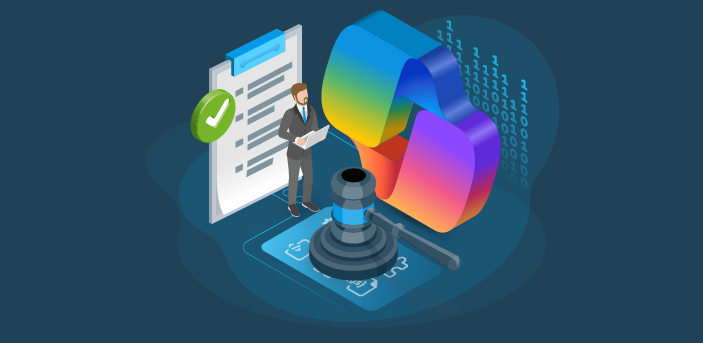Adopting Microsoft 365 Copilot without preparation is like starting a football match without marking the field, setting the rules, and ensuring fair play. The result is confusion, chaos, and unnecessary risk. To unlock Copilot’s full potential, organizations need clear policies, secure boundaries, and a solid AI governance strategy.
This Copilot implementation guide walks you through eight essential Microsoft Copilot governance best practices that will help you protect sensitive data, avoid misinformation, control license costs, and build the foundations for safe, productive AI adoption.
1. Define clear governance policies
Before a single user is granted a Copilot license, you must establish the rules of the road. A clear governance policy is the foundational document for your entire AI strategy. It sets expectations, defines boundaries, and creates a framework for accountability, ensuring robust governance across your organization. The goal isn’t to limit usage, but to empower users to leverage Copilot effectively, securely, and responsibly.
Formalize rules
Your AI governance policy should be a formal, accessible document that addresses key questions:
- Acceptable use: What are the approved use cases for Copilot within your organization? Specify which tasks or departments should actively use it and where restrictions apply.
- Data handling: How should employees use Copilot when working with sensitive, confidential, or PII (Personally Identifiable Information)? Define clear protocols for interacting with regulated data.
- Intellectual property (IP): Who owns the content generated with Copilot? Clarify that company IP generated with or by Copilot remains the property of the organization. Outline guidelines for protecting trade secrets and proprietary information.
- Verification and accountability: Who is responsible for ensuring the accuracy and quality of AI-generated content? Copilot is an assistant, not an infallible expert. Mandate that users must review, edit, and take ownership of the final output.
- Roles and responsibilities: Who owns the AI governance strategy? Designate a committee or individuals from IT, Legal, Compliance, and business units to oversee policy creation, enforcement, and evolution.
Maintain audit trails
A policy is only effective if you can monitor compliance. To meet regulatory requirements and conduct security investigations, you must maintain comprehensive audit trails of Copilot activity. This is a cornerstone of Microsoft Copilot security. That means tracking:
- User activity: Who is using Copilot, which applications are they using, and what types of prompts are being submitted? Monitor these patterns to understand adoption and identify unusual behavior.
- Data access: What information is Copilot retrieving to generate responses? Track this carefully to support data security and privacy audits, strengthen regulatory compliance, and reduce risk exposure.
- Policy violations: What activities indicate a breach of your governance policies, such as attempts to access data outside authorized permissions? Implement monitoring systems that flag and alert administrators in real time.
Full traceability is non-negotiable for organisations seeking GDPR-grade control and alignment with emerging regulations, such as the EU AI Act.
2. Secure and classify data
Microsoft 365 Copilot operates within your organization's unique "data boundary," meaning it only accesses information that a specific user already has permission to see. This is a critical security feature, but it has a profound implication: if your data landscape is a mess, Copilot will amplify that chaos and put data integrity at risk.
The principle of "garbage in, garbage out" has never been more relevant. Microsoft Copilot’s responses are only as accurate and reliable as the content it can access. If your SharePoint sites and OneDrive accounts are cluttered with outdated, trivial, or orphaned files, you create two major risks:
- Misinformation: Copilot may surface outdated policies, incorrect project data, or conflicting information from duplicate documents, leading to poor decisions.
- Unintended information discovery: Users might stumble upon sensitive files that, while technically accessible, were buried in unmanaged site collections.
To mitigate these risks, secure and classify your data before Microsoft 365 Copilot deployment.
Declutter your tenant
Remove ROT (Redundant, Obsolete, Trivial) content that clutters your SharePoint and OneDrive environments. Outdated or duplicate documents can cause Copilot to surface conflicting or incorrect information, leading to misinformation.
Manage content lifecycle
Automate policies that archive or delete stale sites, Teams, and files. Without data lifecycle management, Copilot may expose hidden but still-accessible content that users were never meant to find, increasing compliance risks.
Apply sensitivity labels
Use Microsoft Purview Information Protection to classify data with sensitivity labels such as Public, Internal, Confidential, or Highly Confidential. Copilot respects these labels, helping to prevent the unintentional discovery or misuse of sensitive organizational data.
3. Manage access and permissions
Because Copilot inherits existing user permissions, your access management model is now more critical than ever. Overly permissive access, a common issue in sprawling Microsoft 365 tenants, is a ticking time bomb. Copilot makes it trivially easy for a user to query across all the data they can access, potentially exposing sensitive information from old projects or teams they should no longer be a part of.
A robust approach to managing permissions is central to Microsoft Copilot data governance. You must enforce the principle of least privilege: users should only have access to the information strictly necessary to perform their jobs.
Review access
Manual access reviews are time-consuming and prone to error. To scale effectively, you need an automated process for regularly certifying user access.
- Automate certification: Implement tools that automatically trigger periodic access reviews, asking data owners or managers to confirm that their team members' permissions are still appropriate.
- Delegate responsibility: Empower business users to manage their own access reviews through user-friendly interfaces, reducing the burden on IT while increasing accountability.
Monitor offboarding and role changes
When an employee leaves the company or changes roles, their access rights must be updated immediately. A lingering account is a significant security vulnerability. Likewise, an employee moving from Finance to Marketing should not retain access to sensitive financial reports.
Automating these de-provisioning and modification processes is essential. Integrate your governance solution with your HR system to ensure that access rights are adjusted in real-time based on employment status and role, securing your data and strengthening your overall Microsoft Copilot security posture.
Fix broken or misconfigured permissions
Even with strong access control policies, permissions in Microsoft 365 can become broken over time due to role changes, group nesting, or legacy setups. These misconfigurations create blind spots and security gaps. As part of your Copilot governance program, implement tools and workflows to detect and repair broken permissions. This ensures that Copilot queries never expose data through accidental oversharing or access by unauthorized users.
4. Control costs and licenses
A Microsoft 365 Copilot license represents a substantial financial commitment. To justify this expense, you need to ensure the tool is not only being used but is also delivering tangible value. Without a clear strategy for managing licenses and tracking ROI, you risk spending a significant amount on "shelfware" and missing opportunities to align with Microsoft Copilot pricing strategies.
Roll out in phases
Begin with a pilot program for a specific group of users or a department. This allows you to gather feedback, measure initial impact, and build a business case before a full-scale deployment.
Monitor usage and adoption
Track key metrics to understand how Copilot is being used. Which users are the most active? Which applications see the most Copilot activity (Teams, Outlook, Word)? This data is invaluable for identifying champions and areas where more training may be needed.
Optimize license allocation
Continuously monitor license allocation. If users who were part of the initial rollout aren't actively using Copilot, reclaim those licenses and reassign them to those who will. Implement chargeback models to assign costs to the business units that are benefiting from the technology. This keeps Copilot adoption both accountable and financially sustainable.
5. Train and cultivate culture
Technology alone cannot guarantee success. Your people are the most critical component of your Copilot strategy. A cultural shift towards responsible AI usage, supported by comprehensive training, is one of the most important Microsoft Copilot best practices.
Build a governance-minded culture
Governance should not be seen as a set of restrictive rules imposed by IT. It must be a shared responsibility, a collective commitment to using technology wisely and securely.
- Communicate the 'why': Explain to employees why governance policies are in place: to protect the company, its data, and its customers. Frame it as an enabler of safe innovation, not a barrier.
- Establish AI champions: Identify and empower a network of AI champions across different departments. These enthusiasts can provide peer support, share success stories, and promote best practices from the ground up.
Train the users
Effective training goes beyond a simple "how-to" demo. It must equip users with the skills and awareness to use Copilot as a responsible digital partner. Your training program should cover:
- Prompt engineering: Teach users how to write clear, specific, and contextual prompts to get the best possible results from Copilot.
- Critical evaluation: Train users to critically evaluate and verify AI-generated content. They must understand Copilot's limitations and their ultimate responsibility for the final output.
- Policy and ethics: Ensure every user understands your organization's AI acceptable use policy, data handling rules, and the ethical considerations of using generative AI.
A well-informed and well-trained workforce is your first and best line of defense against AI misuse and a driver of long-term business success.
Enable self-service governance
Governance works best when end users are active participants. Providing governance tools directly in Microsoft Teams empowers employees to review access, permissions, and lifecycle tasks in the apps they use every day. For example, end users can confirm whether the right people still have access to a SharePoint site, or request the de-provisioning of unused Teams. This reduces IT workload and strengthens accountability across the organization.
6. Automate governance workflows
As your Microsoft 365 and Copilot usage grows, manual governance becomes impossible. You cannot rely on spreadsheets and IT tickets to manage thousands of users, millions of documents, and countless AI interactions. The only way to govern at scale is through automated data management and policy enforcement. Automation transforms governance from a reactive, burdensome task into a proactive, continuous process that runs in the background.
Enforce policies automatically
Detect and remediate policy violations in real time, for example, blocking the external sharing of a document newly classified as “Confidential.” Automation ensures rules are applied consistently and strengthens content security.
Manage lifecycle at scale
Archive inactive Teams and SharePoint sites automatically. This keeps your tenant lean, reduces the data Copilot has to query, and minimizes the risk of outdated content fueling misinformation.
Automate access reviews
Replace manual certifications with automated access reviews. By keeping permissions continuously up to date, you reduce security risks and ensure Copilot only surfaces content users are truly authorized to see.
Detect orphaned content
Automatically identify resources such as M365 Groups or Power Apps with no valid owner. Assigning ownership quickly prevents compliance gaps and ensures accountability.
Automate provisioning with templates
Standardize workspace creation with automated provisioning workflows and predefined templates. Include Purview sensitivity labels and naming conventions from day 1 to prevent sprawl and ensure every new Team or SharePoint site meets security and compliance requirements.
7. Monitor and optimize continuously
Your Copilot governance strategy is not a "set it and forget it" project. The world of AI is evolving at a breathtaking pace, and your governance framework must evolve with it. Continuous monitoring and optimization are essential for long-term success and security.
This includes monitoring for new services and risks, such as the rise of custom AI agents built with Copilot Studio. Understanding the key differences between Microsoft 365 Copilot and Copilot Studio is crucial, as custom agents introduce new governance challenges, including connector management and "shadow agent" sprawl.
Maintain a complete inventory
Build and maintain a 360° view of all Copilot-related assets. This includes users, licenses, and custom agents. Without a comprehensive inventory, you risk losing control over sprawl, costs, and compliance.
Track key metrics
Analyze usage, adoption rates, and policy violations regularly. Metrics provide evidence of value, highlight areas for improvement, and help you spot risks before they escalate.
Gather user feedback
Provide structured feedback channels so employees can share their Copilot experiences. Input from daily users ensures policies remain practical and widely adopted.
Leverage scheduled and dynamic reporting
Automate reporting to keep stakeholders informed about adoption, costs, and compliance. Dynamic dashboards let IT and compliance teams drill into issues in real time, turning governance from reactive firefighting into proactive risk management.
Stay ahead of emerging risks
Continuously monitor new AI capabilities, evolving regulations, and potential vulnerabilities. Emerging risks, from agent sprawl to new compliance rules, require proactive adjustments to ensure a resilient governance framework.
Use all these insights to refine your policies, update your training materials, and adjust your technical controls. This iterative loop of monitoring, learning, and optimizing is what separates good governance from great governance. It ensures your Copilot governance best practices remain effective over time and supports strong AI risk management.
8. Use Rencore for Microsoft Copilot governance
Navigating the complexities of a Microsoft 365 Copilot deployment can feel overwhelming. The best practices outlined above provide a clear roadmap, but implementing them at scale requires the right tools. This is where Rencore Microsoft Copilot Governance comes in to transform the implementation guide into automated governance processes that scale with your business.
We built our platform to address the exact pain points you face, from information chaos and security risks to cost control and the need for scalable automation. Rencore provides a single pane of glass to discover, manage, and govern your entire Microsoft 365, Power Platform, and Copilot environment.
Here’s how we help you implement these Microsoft Copilot governance best practices:
- Visibility (Practices #2, #7): We provide a complete, 360° inventory of all your M365 assets. We help you find and declutter orphaned, stale, and duplicate content to ensure Copilot works with clean, accurate data. In addition, we uncover custom agents built with Copilot Studio, giving you control over this emerging risk and strengthening Microsoft Copilot Studio governance.
- Control (Practices #1, #3): Our flexible policy engine allows you to implement and enforce your specific governance rules. Automate access reviews and lifecycle management to ensure the principle of least privilege is always maintained.
- Automation (Practice #6): We turn manual, time-consuming governance tasks into automated workflows. From policy enforcement to user offboarding, Rencore handles the heavy lifting, allowing you to govern at scale without overwhelming your IT team.
- Optimization (Practice #4): Our dashboards provide clear insights into license usage and adoption, helping you optimize costs and demonstrate the ROI of your Copilot investment.
- Audit-Readiness (Practices #1, #3): With comprehensive audit trails and automated reporting, Rencore accelerates your audit readiness and helps you confidently meet compliance requirements like GDPR.
- Self-Service (Practice #5): With our Rencore app for Microsoft Teams, end users can review and manage access, permissions, and lifecycle tasks themselves, directly in the tools they already use. This reduces IT workload, ensures accountability, and simplifies end-user participation in governance processes.

Conclusion: Prepare your AI governance strategy for today and tomorrow
Microsoft Copilot governance starts with the fundamentals: securing your data, tightening permissions, managing licenses, automating policies, and cultivating a culture of responsible AI use. These best practices create the foundation for a safe, compliant, and productive Copilot deployment. They also demonstrate why AI governance matters now, as organizations face growing expectations from regulators, security teams, and business stakeholders.
Looking ahead, governance challenges will not stop at Copilot itself. With the growing adoption of Copilot Studio and custom agents, new risks around sprawl, ownership, security, and cost will emerge. While this guide has focused on Copilot governance, it is important to prepare for the next step: agent governance. Building visibility and control mechanisms today will ensure your organization is ready to manage not only Microsoft Copilot, but also the broader ecosystem of AI assistants that will inevitably follow, without losing control in the content jungle.




